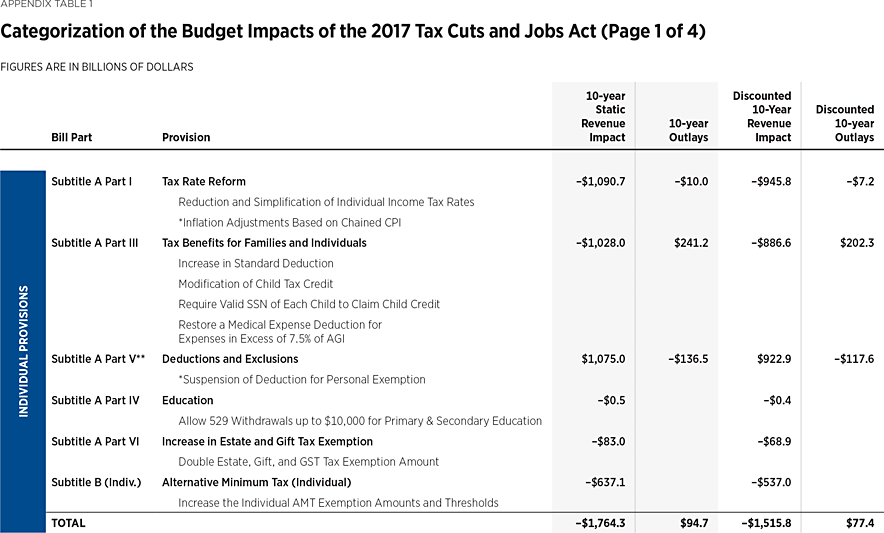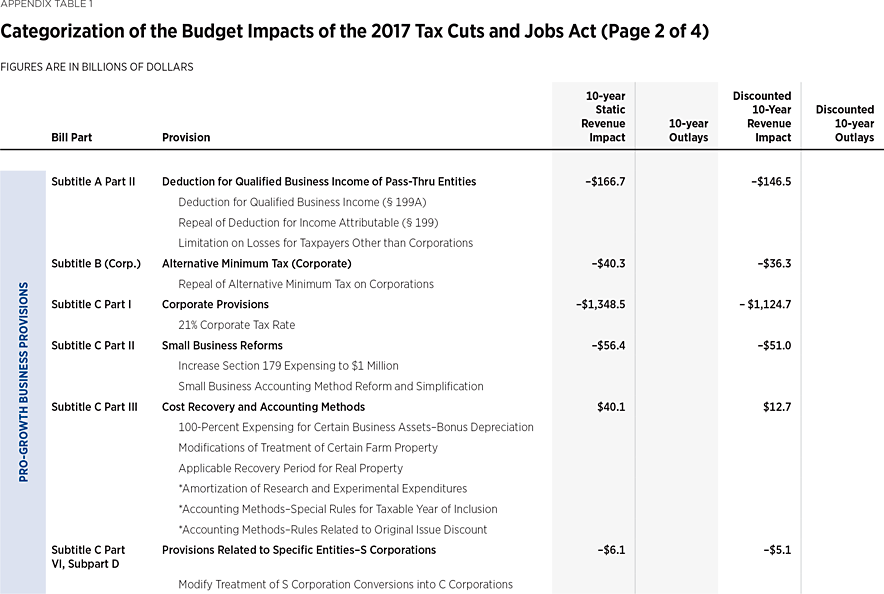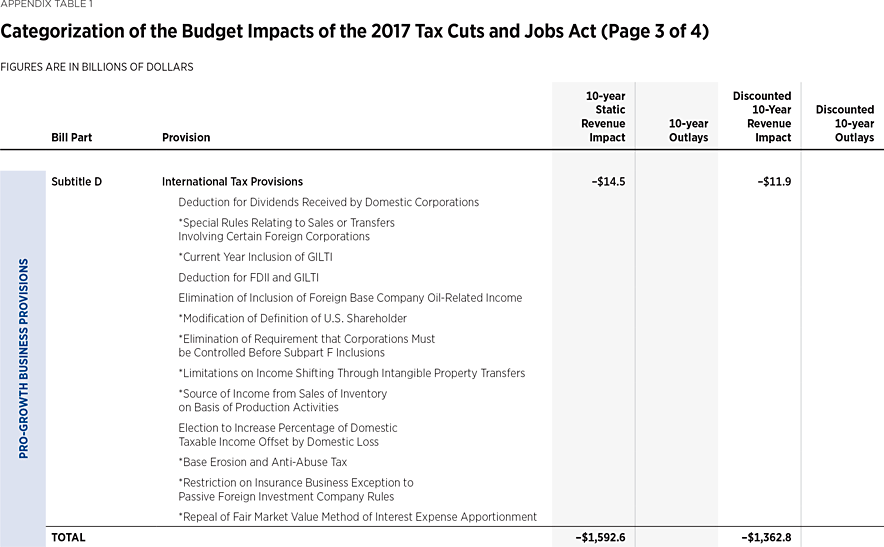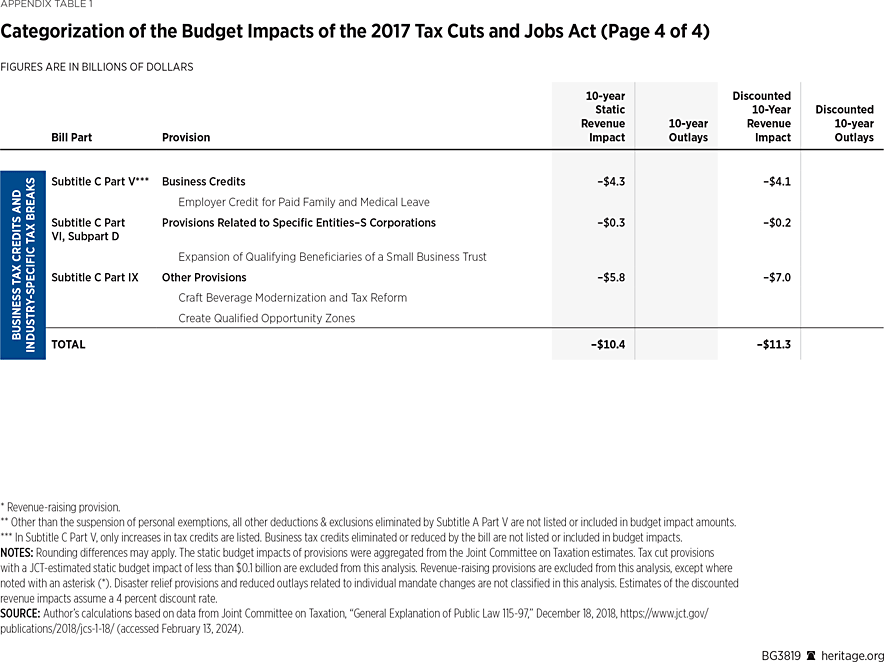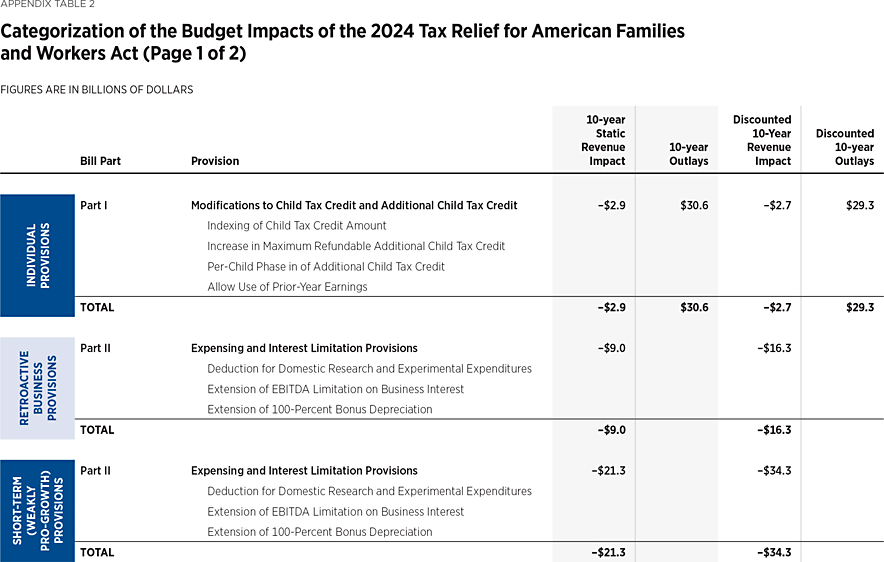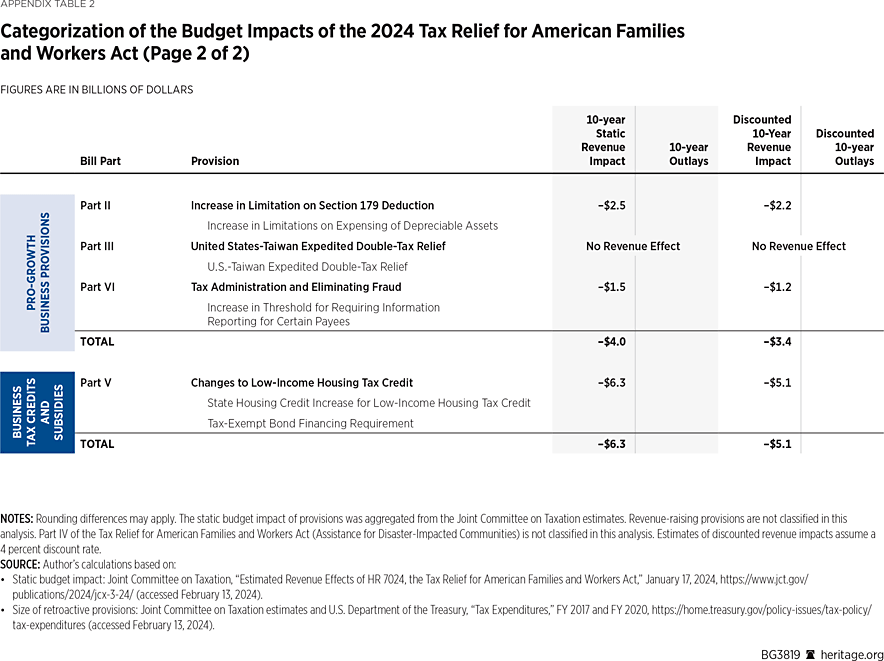The House of Representatives passed the Tax Relief for American Families and Workers Act (TRAFWA) on January 31, 2024. Forty-seven Republicans and 23 Democrats voted against the bill, which would increase additional child tax credit (ACTC) payments to taxpayers whose annual income is low enough to not owe any income taxes, and which would temporarily and retroactively extend some expiring business-expensing provisions, among other changes.REF Now the House bill moves to the Senate, where it is expected to face stronger opposition.
The flaws in TRAFWA are most clearly seen when contrasted with the major tax legislation that came before it, the 2017 Tax Cuts and Jobs Act (TCJA). This Backgrounder demonstrates the stark difference between the composition of the two pieces of legislation. As described below, the vast majority of the tax cuts in the 2017 TCJA fall into one of two categories: (1) tax cuts for families and individuals or (2) pro-growth business reforms.
The House-passed bill is very different. The individual relief in the bill consists almost entirely of new outlays to non-income taxpayers, that is, they are spending increases rather than tax cuts. A significant portion of the business tax relief involves retroactive tax changes that have no net economic benefit or involves harmful, preferential subsidies. Most of the rest of the bill provides a temporary two-year tax cut that may be weakly pro-growth. This Backgrounder categorizes and quantifies the share of the budget effect of both bills that consists of: (1) individual tax cuts, (2) cash outlays to individuals, (3) pro-growth business tax cuts and reforms, (4) short-term business relief, (5) retroactive business tax relief, and (6) corporate tax credits and subsidies.
Backsliding from Tax Reform to “Relief”
Supporters of the House-passed tax-welfare bill have suggested that it is a continuation of the successful TCJA, the tax reform legislation that was passed and signed into law during President Donald Trump’s first year in office. There is a grain of truth to this argument. TRAFWA does, for example, include a temporary two-year extension of expensing of assets like equipment and machinery, a 2017 TCJA provision. The expiration of this and two other business provisions would be aligned with the looming expiration of most of the individual tax cuts in the TCJA, with the apparent hope of a larger extension after the scheduled expirations on December 31, 2025.
However, in a more meaningful sense, TRAFWA is a radical departure from the conservative, growth-oriented reforms of the TCJA. The TCJA reduced harmful double taxation and made the U.S. a much more attractive place to do business, whether to build factories or to set up corporate offices. The reforms were a boon to workers who achieved impressive wage growth following the 2017 reform, up until the pandemic-related government shutdowns of 2020.REF The TCJA broadened the tax base and simplified the tax code by eliminating a wide array of preferential tax credits and deductions, and, in turn, reduced tax rates for businesses and individuals. The 2017 reforms, in short, were well designed. The TCJA was not perfect, but the sensible reforms in the legislation dramatically outweighed the bad.
In contrast, TRAFWA offers no substantial new positive reforms. It modestly increases the amount of capital expenses that small and midsize businesses can immediately take as a deduction rather than requiring them to depreciate. It also includes a two-year extension of some beneficial expiring business provisions, but it pairs these changes with unhelpful retroactive changes and expanded subsidies to housing developers.
Furthermore, instead of reducing taxes for individuals and families, more than 91 percent of the “relief” for families in TRAFWA consists of outlays: payments from the federal government to households who pay no income taxes.REF One could call this “relief,” or one could call it “welfare with a work requirement.” Regardless, it is inaccurate and misleading to refer to it as a tax cut. The issue at stake is not simply whether Congress should expand the already large welfare state, but whether it should do so under the guise of “tax relief.”
Categorizing the Tax Provisions in the 2017 Law and the 2024 Bill
The analysis that follows first describes and categorizes the individual tax cuts in the 2017 TCJA, and then those in the 2024 TRAFWA bill. The categorization of individual provisions as individual tax cuts versus new outlays uses analysis by the government scorekeepers at the Joint Committee on Taxation (JCT).REF
Next, this analysis describes and categorizes the business provisions in the 2017 law and the 2024 bill. This analysis assigns business tax-cutting provisions to one of four categories: (1) pro-growth tax cuts, (2) short-term (weakly pro-growth) tax relief, (3) retroactive tax relief, and (4) corporate tax credits and subsidies. To be placed in the pro-growth category, a provision must lower marginal tax rates, remove duplicative taxes or otherwise reduce some bias, improve economic incentives, or offer a simplification of business taxes. It also must not be short-term (defined here as provisions lasting three or fewer years), retroactive, a tax credit or subsidy, or targeted to a specific industry.
To be counted as short-term business tax relief, a provision must also be in effect for no longer than three years.REF Retroactive tax relief must apply to tax years before the TCJA passed, making it impossible for it to change business decisions. The final category includes new or expanded tax credits and targeted tax advantages (not merely removing disadvantages) to an industry or activity. Although there is some subjectivity in the classification process, the ambiguous cases mostly relate to provisions with small budgetary effects, so they have little quantitative effect on the final allocation.REF
This analysis excludes tax-cutting provisions with a JCT-estimated budget effect of less than $100 million over 10 years (such provisions together account for about 0.01 percent of the JCT-estimated revenue reductions in the 2017 TCJA). Also, this is an analysis of the tax cuts in the law and the bill, not of the revenue-raising provisions.
The categorization process excludes provisions that increase revenues—with a few exceptions.REF First, this analysis combines the positive revenue effect of the TCJA’s suspension of the personal exemption with the negative-revenue effect of the TCJA’s increase in the standard deduction and child tax credit. Second, this analysis combines the negative-revenue effect of changes in individual tax brackets with the positive revenue effects of changes to bracket indexing.REF Third, the TCJA’s capital-cost-recovery provisions (which included positive and negative revenue effects) are considered jointly. Fourth, the analysis jointly considers the effects of the TCJA’s deduction for qualified business income (§ 199A) with the smaller deduction for qualified production-activities income (§ 199), which it replaced, as well as the limitation on losses for taxpayers other than corporations. Finally, the TCJA’s international provisions are considered jointly.REF (See the appendix for more details.)
Individual Tax Cuts vs. Cash Payments to Non-Income Taxpayers
This section first describes the individual tax provisions in the TCJA, categorizing and depicting the share of the individual provisions in the law that were tax cuts as opposed to cash outlays to individuals who owed no annual income taxes. Then, it similarly describes, categorizes, and depicts the share of individual provisions in the 2024 TRAFWA bill. All TCJA and TRAFWA individual provisions with a 10-year budget effect of at least $100 million are included in the analysis (see appendix), however for brevity, the TCJA provision summaries below are limited to those with a 10-year budgetary effect of at least $2 billion.REF
2017 Tax Cuts and Jobs Act: Individual Provisions. The JCT estimates of the tax reductions in the TCJA were split roughly evenly between individual provisions and business provisions. The individual tax cuts concentrated most heavily on tax rate reductions. Several TCJA individual provisions also simplified the tax filing process for American families.
The TCJA included the following notable changes to individual taxes (effective through 2025):REF
- Reduction of individual income tax rates. For most individual tax brackets, the TCJA reduced marginal tax rates by between one and four percentage points. For example, it reduced the top bracket from 39.6 percent to 37 percent, and it reduced the 15 percent bracket to 12 percent. (In 2023, the 12 percent bracket applied to between $11,000 and $44,725 of taxable income for single taxpayers).REF
- Increase in the standard deduction. The standard deduction for singles in 2017 was $6,350, and for married joint filers it was $12,700.REF The TCJA nearly doubled those amounts to $12,000 and $24,000, respectively, in 2018. (With cost-of living adjustments the 2023 standard deductions for single and married filers were $13,850 and $27,700, respectively).REF
- Expansion and modification of the child tax credit (CTC). The TCJA increased the CTC from $1,000 per qualifying child to $2,000. This is the amount of income tax liability that taxpayers can offset (but not below zero) with CTCs. The TCJA also pushed the phase-out of the CTC higher up the income scale.
- Expansion and modification of the additional CTC (ACTC). The ACTC is the amount of the CTC that can be used to reduce net income tax liability below zero, meaning that non-income taxpayers receive checks from the IRS. The TCJA increased this amount from $1,000 to $1,400 (with cost-of-living adjustments) and set the ACTC phase-in to begin at $2,500 of earned income instead of $3,000.
- Suspension of personal exemptions. The TCJA partially offset the tax reductions from the increased standard deduction and CTC with additional revenues from suspending personal exemptions through 2025. Prior to the TCJA, taxpayers could generally exempt $4,050 per tax filer and dependent.REF For taxpayers at or below the 25 percent income tax bracket, the $1,000 CTC expansion more than offset the loss of the dependent exemption.
- Expansion of the exemption from the alternative minimum tax (AMT) for individuals. The individual AMT is a parallel tax calculation to the regular individual income tax system. The individual AMT allows a sizable exemption and fewer deductions than the regular individual income tax. It also applies only two rates, 26 percent and 28 percent. The TCJA roughly doubled the exemption for the individual AMT, helping many taxpayers to avoid the complications of calculating their taxes in two ways and paying the higher of the two computations.
- Expansion of the exemption from death taxes. The TCJA doubled the basic exclusion amount (BEA) from estate and gift taxes.
- Setting of the Affordable Care Act “individual mandate” penalty to zero. Under the 2010 health care law, people who did not purchase qualifying insurance were assessed a penalty (ruled by the Supreme Court to be a tax). The TCJA set this penalty to zero. Based on JCT scoring, this was a tax cut but also led to a large reduction in outlays as the JCT expected that the change would lead fewer Americans to claim and receive payments via the refundable Premium Tax Credit.
Analysis of the 2017 TCJA’s Individual Changes
While the individual changes in the TCJA mostly affected tax revenues, some TCJA provisions also had an outlay effect. Most notably, the modifications to the ACTC involved cash payments from the IRS to individuals who owed no annual income taxes. Also, some of the other tax cuts indirectly allowed increased outlays. For example, the increased standard deduction made the ACTC “refundable” amount applicable to more taxpayers.
Technically, the TCJA reduced federal outlays according to the JCT score. Nearly $300 billion of reduced outlays reflected Obamacare subsidies that the JCT estimated the government would no longer have to pay because the TCJA zeroed out the penalties associated with the individual mandate.REF If the reduction in outlays from the individual mandate changes is considered an offset to other increases in outlays from other TCJA provisions, then 100 percent of the individual changes in the TCJA would be tax cuts, not increased outlays.REF
Even excluding the changes related to the individual mandate from the analysis, about 95 percent of the individual relief in the 2017 TCJA reflected tax cuts compared to about 5 percent that was increased outlays. Chart 1 shows the TCJA’s reduction in individual taxes alongside the estimated change in outlays to individuals, with the individual-mandate outlay changes shown separately.
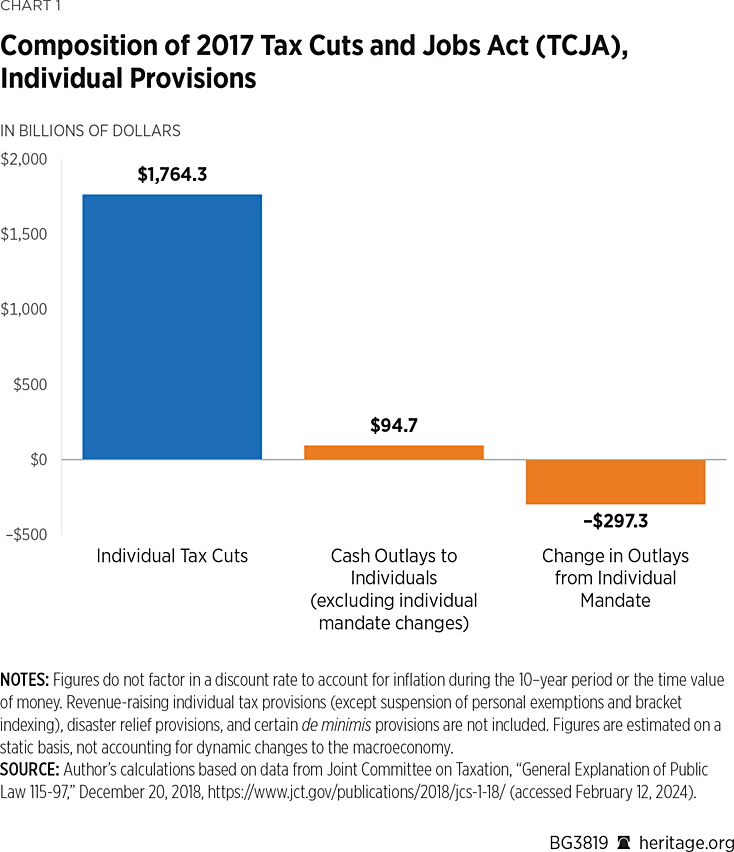
After Chart 1, which shows both the increase in outlays to individuals and the decrease from the individual mandate, the analysis that follows uses the less favorable accounting of the TCJA: The reduction in outlays related to the individual mandate changes is not counted as offsetting increased cash outlays. (See the appendix for more details of the analysis.)
Tax Relief for American Families and Workers Act: Individual Provisions. The 2024 TRAFWA bill would make one modification to the CTC and three changes to the outlay portion of the credit (the ACTC). Specifically, TRAFWA would:REF
- Temporarily index the CTC to inflation. The bill would apply a cost-of-living adjustment to the per-child CTC amount of $2,000, but only for tax years 2024 and 2025. The cost-of-living adjustment would be pegged to 2022 and rounded down to the nearest $100, likely resulting in a CTC of $2,100 for each of the next two years. The CTC would still be set to revert to $1,000 after 2025, as it is under current law.REF
- Increase the per-child ACTC. TRAFWA would increase the per-child ACTC amount (the amount of benefit that can be received as a cash benefit instead of a tax offset) from $1,600 to $1,800 in 2023, to $1,900 in 2024, and to $2,000 in 2025. After applying inflation adjustments, the ACTC would be equal to the CTC in 2025. These changes would not apply after 2025.
- Accelerate the phase-in of the ACTC. Under current law, the ACTC phases in at 15 percent of earnings above $2,500. TRAFWA would change the phase-in rate to 15 percent multiplied by the number of children claimed.
- Allow a two-year lookback. TRAFWA would enable taxpayers to choose to claim a CTC or ACTC based on the prior tax year if the current tax year’s earned income is less. This would weaken the CTC work requirement, meaning that working every other year would be sufficient to meet it.
Analysis of TRAFWA’s Individual Changes
Of the four changes described above, only the first is a clear tax cut.REF Each of the other three is entirely or mostly an expansion of government spending. Based on JCT scoring, $30.6 billion out of the $33.5 billion budget impact of the four individual provisions are new outlays, not tax cuts. In other words, more than 91 percent of the relief would be payments to families with no income tax liability.REF
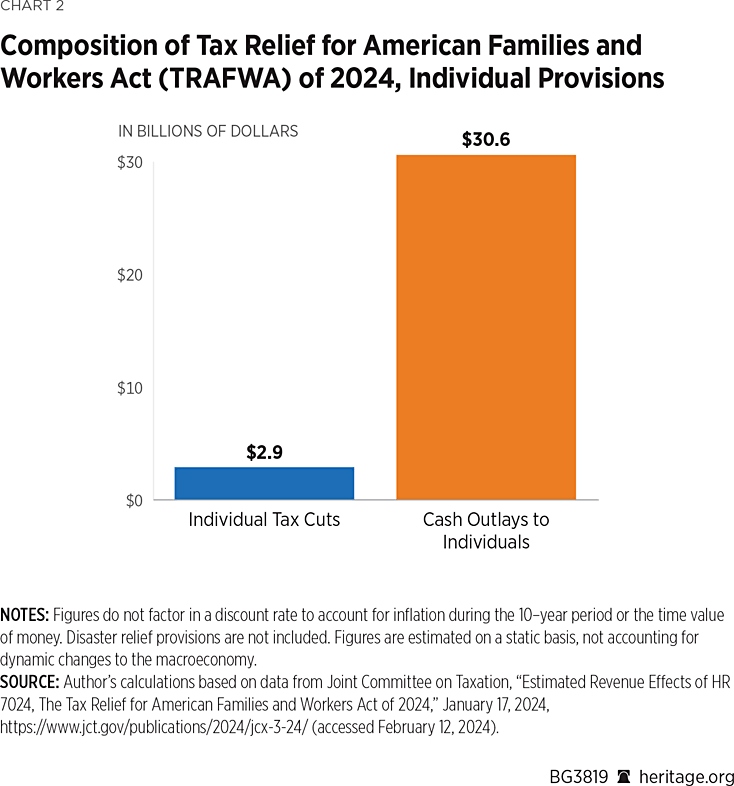
Unlike with the TCJA, where the individual relief was heavily skewed toward tax cuts, TRAFWA’s individual changes heavily skew toward cash payments to individuals with no income tax liability. Chart 3 compares the composition of individual provisions of the 2017 TCJA to the individual provisions in TRAFWA.REF (See the appendix for more details of the analysis.)

Business Tax Cuts
For business tax reforms to be meaningfully pro-growth, they should lower tax rates, eliminate harmful tax biases, reduce disincentives against entrepreneurship or the expansion of existing businesses in the United States, or offer simplifications that allow companies to reduce overhead costs. Such changes are forward-looking and help to create a more attractive business climate.
At a minimum, to be considered pro-growth, business tax provisions should not be retroactive or provide preferential tax credits or other subsidies. Such changes do not improve the general business climate; rather they encourage industries and businesses to increase their lobbying efforts. To truly transform and improve the country’s business climate, business reforms should be permanent. Short-term tax provisions subject businesses to a more uncertain future business climate that may make them reluctant to invest.
2017 Tax Cuts and Jobs Act: Business Provisions
This section describes the business tax provisions in the TCJA, categorizing and depicting the share of the provisions in the law that consisted of (1) pro-growth tax cuts, (2) short-term (weakly pro-growth) tax relief, (3) retroactive tax relief, and (4) corporate tax credits and subsidies. All TCJA business provisions with a 10-year budget effect of at least $100 million are included in the analysis (see appendix), however, for brevity, the TCJA provision summaries below are limited to pro-growth business provisions with a 10-year budgetary effect of at least $10 billion and all other business provisions with a 10-year budgetary effect of at least $1 billion.
Pro-Growth Business Tax Provisions. The TCJA business tax cuts focused on four main pro-growth objectives: (1) reducing marginal tax rates for corporations and pass-through businesses, (2) moving to full and immediate expensing of formerly depreciable expenses, (3) simplification of business taxes, and (4) reducing double taxation of U.S.-based companies with international operations.
A basic tenet of tax policy is that low rates and a broad base, properly defined, are preferable to higher rates with many carveouts. The higher the marginal tax rate on a productive activity like earning business income, the less incentive there is to do it, and the greater incentive businesses have to avoid the tax by moving or altering their activities. The TCJA had two large provisions geared toward business tax rate reduction. The TCJA:REF
- Permanently reduced the corporate tax rate from 35 percent to 21 percent. This change moved the U.S. from having the highest (combined federal, state, and local) corporate tax rate in the developed world to near the median; and
- Enacted a 20 percent qualified business income deductionfor certain pass-through businesses. Although technically a new deduction, it generally acts like a rate reduction, except that it is larger for those facing higher marginal tax rates. This deduction is set to expire in 2025.REF
“Expensing” provisions allow businesses to deduct certain categories of costs as soon as the expense is borne or the associated asset is placed into service, as opposed to using often long and convoluted depreciation schedules. Most valid business costs are immediately deductible, so these changes remove unnecessary and economically harmful biases that stunt business investment. The TCJA included a few expensing provisions, the most consequential of which are listed below. The TCJA:REF
- Implemented bonus depreciation. This allowed full and immediate expensing for an array of new business equipment, machinery, vehicles, furniture, and certain computer software. Pre-TCJA, these assets had depreciation schedules of as many as 20 years. One hundred percent bonus depreciation was an important pro-growth reform that was in effect from 2018 through 2022, though unfortunately the TCJA set the bonus depreciation to phase-out by 20 percent per year after the end of 2022, fully expiring after 2026.
- Increased the limitation on the Section 179 deduction in the Internal Revenue Code. The Section 179 deduction is a more limited expensing provision that applies to certain tangible property, computer software, and certain real property improvements like roof repairs, subject to a cap. Prior to the TCJA, the cap on the Section 179 deduction was $500,000. The TCJA increased it to $1 million, setting the phase-out to start at $2.5 million of applicable expenses.
Part of the advantage of expensing provisions is that they simplify tax accounting for taxpayers. Two other significant corporate provisions helped to streamline the tax and accounting process for businesses. Namely, the 2017 TCJA:REF
- Eliminated the corporate alternative minimum tax (AMT). The 2017 TCJA eliminated the corporate AMT, a parallel 20 percent corporate tax on an alternative tax base. Prior to repeal, businesses had to calculate their tax liability under both systems. When they paid corporate AMT one year, they could potentially credit the extra tax liability against future “regular” tax liabilities in years where the corporate AMT did not apply. Despite the large administrative burden it imposed, the tax raised little net revenue.REF
- Modified and simplified small business accounting methods. Under prior law, certain business taxpayers with gross receipts of less than $25 million were allowed to use the simpler cash method of accounting instead of accrual-based accounting. Among other accounting changes, the TCJA expanded the set of taxpayers that could elect cash accounting to include taxpayers that generate income from the sale of merchandise (if their income is below the $25 million gross receipts threshold).
Finally, the TCJA implemented a host of reforms to the international tax system that moved the U.S. away from its counterproductive worldwide tax system. Under a worldwide tax system, a multinational company headquartered in the U.S. with international subsidiaries would be subject to U.S. tax not only on its activities in the U.S., but also on its foreign subsidiaries’ activities. In most cases companies could claim foreign tax credits (FTCs) to offset foreign taxes already paid, but since the U.S. had one of the highest corporate tax rates in the world, companies would typically owe taxes in both countries. Prior to the TCJA, the United States was one of only a handful of developed countries with a worldwide tax system. The U.S.’s outdated international tax system was a deterrent to companies locating their headquarters in the United States and often led to offshoring and U.S.-based multinationals leaving their international subsidiaries’ profits sitting unrepatriated overseas.
In contrast, under a territorial system, multinational companies owe taxes in each country based on the activities performed there. The international provisions in the 2017 TCJA moved the U.S. to a hybrid system in which territorial rules applied in most situations, though certain situations would trigger U.S. taxation of foreign activities. The TCJA’s international reforms cut down on double taxation in many cases. The revenue-raising international tax provisions, such as the base erosion anti-abuse tax and the global intangible low-taxed income provisions, did introduce some new problems.REF This analysis treats the net reduction in taxes from the international provisions as pro-growth, acknowledging some of the trade-offs that the TCJA made in the international code.REF
Retroactive Provisions, Tax Credits, and Corporate Subsidies in the TCJA
The 2017 TCJA avoided retroactive business tax cuts. The most notable possible exception is that bonus depreciation applied back to assets brought into service as early as September 27, 2017, even though President Donald Trump did not sign the bill into law until December 22, 2017.REF This less-than-three-month difference in timing affected past tax years for very few taxpayers. The chosen September 27 date reflected the release of the TCJA tax framework by Republican Party leaders and President Trump’s announcement of the coming tax overhaul.REF To the extent that the business community expected the tax proposal to be signed into law by the end of 2017, this timing allowance ensured that companies did not have an incentive to delay capital investments until the bill’s passage in the final weeks of 2017. Since the TCJA did not materially change prior-year business tax filings, the analysis that follows does not categorize this or other TCJA business tax provisions as retroactive.
The TCJA added one business tax credit and a few small business tax provisions that could be classified as subsidies for specific industries, businesses, or activities. The budget impact of these provisions was minimal compared to the rest of the bill. The provisions listed below include all TCJA business tax credits, subsidies, and industry-specific tax cuts with a JCT-estimated 10-year budget impact of at least $1 billion (none had an impact greater than $5 billion).
The TJCA:REF
- Created a tax credit for paid family and medical leave. Prior to the TCJA, businesses were already required to provide family and medical leave in certain circumstances, however, paid leave was not required. The TCJA gave employers who offer paid leave a tax credit of between 12.5 percent and 25 percent on wages paid to qualifying employees for up to 12 weeks. While the merits of policies to promote paid leave may be debated, the credit’s purpose was not chiefly to expand the economy.
- Created place-based “opportunity zones.” A relatively small, but misguided provision in the 2017 TCJA helped to pick investment winners and losers based on census tracts. The TCJA allowed the deferral and—depending on some qualifying conditions—partial exclusion of gains from capital gains taxation for certain investments made in specified opportunity zones. While reductions in capital gains are pro-growth, such preferential treatment causes capital to flow into suboptimal investments.REF
- Temporarily changed tax treatment of the craft beverage industry. The TCJA reduced certain excise taxes and applied more favorable interest capitalization rules to craft beverage companies. The wine and beer industry is heavily taxed, so a strong case could be made that such changes reduced bias against these businesses in the tax code. However, as written, the industry-specific changes were also very short-lived (applying for only two years).REF The analysis that follows classifies these changes with the tax credits and subsidies. This gives a more conservative accounting of the magnitude of pro-growth business provisions in the 2017 TCJA.
Analysis of the TCJA’s Business Tax Changes
Combined, the JCT scored the reductions to business tax rates, the repeal of the corporate AMT, small business reforms, the changes to expensing and cost recovery and accounting methods, and the international provisions as having a roughly $1.6 trillion (static) budget impact. (This does not account for dynamic effects from macroeconomic growth.) More than 99 percent of the budget impact of the TCJA business provisions related to pro-growth provisions, rather than retroactive relief or tax credits and subsidies.REF

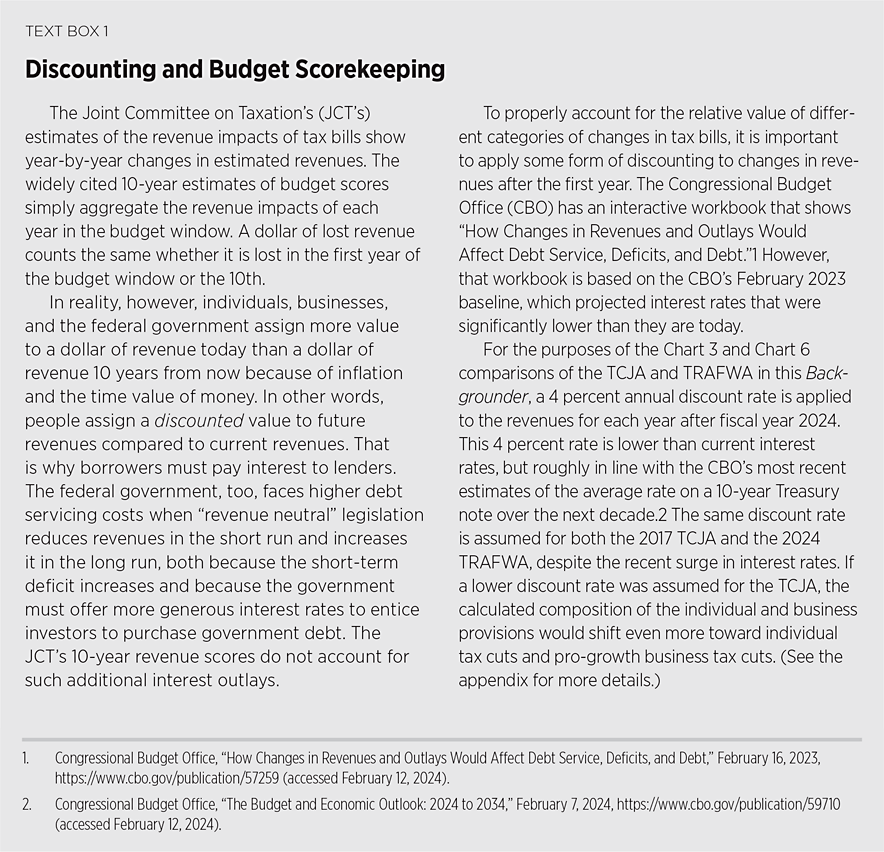
Tax Relief for American Families and Workers Act: Business Provisions
This section describes the business tax provisions in TRAFWA, categorizing and depicting the share of the provisions in the bill that consist of (1) pro-growth tax cuts, (2) short-term (weakly pro-growth) tax relief, (3) retroactive tax relief, and (4) corporate tax credits and subsidies. All TRAFWA business provisions with a 10-year budget effect of at least $100 million are included in the analysis and summarized below.
Pro-Growth Business Tax Provisions in TRAFWA. TRAFWA would permanently implement two modest changes to business tax provisions that are not targeted subsidies or retroactive. In addition, the bill includes three retroactive and temporary extensions, which, if not for their timing, could have been considered solidly pro-growth tax cuts. As it is, the retroactive part of these provisions is not pro-growth, and the temporary two-year extensions are only weakly pro-growth.
The following TRAFWA business provisions would be permanent. TRAFWA would:REF
- Increase the limitation on the Section 179 deduction. TRAFWA would increase the cap on Section 179 deductions from $1.16 million to $1.29 million in 2023. It would also move the beginning of the Section 179 phase-out from $2.89 million to $3.22 million. These changes would be permanent, and these amounts would continue to be inflation-adjusted (as under the TCJA).
- Increase the IRS reporting threshold for payments for services performed by independent contractors. TRAFWA would increase the existing threshold of $600 for IRS information reporting related to Forms 1099-NEC and 1099-MISC to $1,000 and add an inflation adjustment.
The following TRAFWA provisions would expire in less than two years. These changes could be considered solidly pro-growth if they were long-term changes or permanent. TRAFWA would:REF
- Delay amortization of research and experimentation through 2025. To avoid deficits outside the 10-year budget window, the 2017 TCJA allowed five-year amortization of research and experimentation (R&E) expenditures to replace full expensing of R&E starting in 2022.REF TRAFWA would temporarily delay this unfavorable treatment of R&E, so that in 2024 and 2025 businesses would be able to expense R&E immediately.
- Extend bonus depreciation through 2025. TRAFWA would extend the TCJA’s 100 percent bonus depreciation provisions to 2024 and 2025. Under current law, taxpayers would be allowed 60 percent and 40 percent bonus depreciation in those two years.
- Extend increased allowance for business interest deduction. TRAFWA would, for 2024 and 2025, allow businesses to claim interest deductions of up to 30 percent of earnings before interest, taxes, depreciation, and amortization (EBITDA) instead of 30 percent of earnings before interest and taxes (EBIT). Highly debt-leveraged companies would benefit from this change. This is a reversal from the TCJA. While this change is not without controversy, this analysis gives TRAFWA the benefit of the doubt when categorizing the non-retroactive part of this change as weakly pro-growth.REF
Since these latter three provisions would apply for less than two years, this analysis classifies them as “weakly pro-growth.”REF As the JCT explains:
The estimated macroeconomic effects of the bill on GDP [gross domestic product] are so small relative to the size of the economy and the degree of uncertainty associated with the estimate as to be insignificant within the context of a model of the aggregate economy. While the temporary business provisions in the second subtitle [of TRAFWA] decrease the cost of capital and encourage investment in the first three years after enactment, some of this increased investment reflects a forward timing shift of planned investment rather than additional investment that would only occur upon enactment of the bill.REF
Moreover, as discussed below, TRAFWA would also apply each of these three provisions retroactively.
Retroactive Provisions, Tax Credits, and Corporate Subsidies in TRAFWA
Unlike the 2017 TCJA, TRAFWA’s main business tax provisions would apply retroactively. Changes to prior year tax rules do not change incentives and do not meaningfully affect current or future business investment decisions, except to the extent that they increase short-term cash flow. Retroactive business tax cuts may act as a short-term stimulus, but lawmakers should not expect any long-term benefit to the economy or workers. Again, in the words of the JCT: “In addition, the retroactive component of these provisions only has an inframarginal effect on business activity.”REF
TRAFWA would:REF
- Retroactively replace R&E amortization with full expensing in the 2022 and 2023 tax years.
- Retroactively allow 100 percent bonus depreciation (full expensing) in the 2023 tax year.
- Retroactively provide an increased allowance for the business interest deduction for the 2022 and 2023 tax years. The increased business interest allowance would be 30 percent of EBITDA instead of 30 percent of EBIT.
TRAFWA would also expand a harmful and inefficient subsidy to housing developers. The bill would:
- Expand the low-income housing tax credit (LIHTC). The LIHTC subsidizes housing developers for 30 percent of the costs of low-income housing units in developments funded with tax-exempt private activity bonds or 90 percent of the costs of low-income housing units in developments receiving credit allocations from the state housing finance authority. TRAFWA would relax the bond-funding requirements to qualify for the LIHTC and would allow states to allocate more LIHTC credits. This would be an expansion of an already wasteful and convoluted corporate giveaway that mostly benefits housing developers, especially those that are politically well-connected.REF
Analysis of TRAFWA’s Business Tax Changes
The JCT has not provided separate estimates of the budget impact for the retroactive business provisions. It is possible to roughly approximate the impact of the retroactive provisions based on Treasury Department estimates of the annual budget impact of “tax expenditures” from before and after the TCJA.REF
The JCT scored the pro-growth increase in the limitation on increase in the Section 179 deduction and the increased reporting threshold for independent contractors as having a 10-year budget impact of about $4 billion (before discounting).
The JCT scored the expensing provisions for R&E, bonus depreciation, and the more generous interest limitations as having a 10-year cost of about $30.3 billion. Based on this author’s estimates, about $21.3 billion of this amount consists of weakly pro-growth short-term changes affecting tax years 2024 and 2025, and the other $9.0 billion is retroactive relief for 2022 and 2023. The subsidies would have an estimated impact of about $6.3 billion, based on JCT scores. This implies that the TRAFWA business provisions have a split of 9.9 percent pro-growth, 52.5 percent weakly pro-growth, 22.2 percent retroactive business relief, and 15.4 percent corporate subsidies. Assuming a 4 percent discount rate, the share of pro-growth tax cuts is even smaller: 5.7 percent pro-growth, 58.0 percent weakly pro-growth, 27.6 percent retroactive relief, and 8.6 percent corporate subsidies.

Unlike in the TCJA, where the business tax cuts were heavily skewed toward long-term pro-growth tax cuts, a large share of TRAFWA’s business provisions are short-term and retroactive relief or tax credits to subsidize a specific industry. Chart 6 compares the composition of the business provisions of the 2017 TCJA to the business provisions in TRAFWA, based on an assumed 4 percent discount rate to account for the time value of money. (See the appendix for more details of the analysis.)
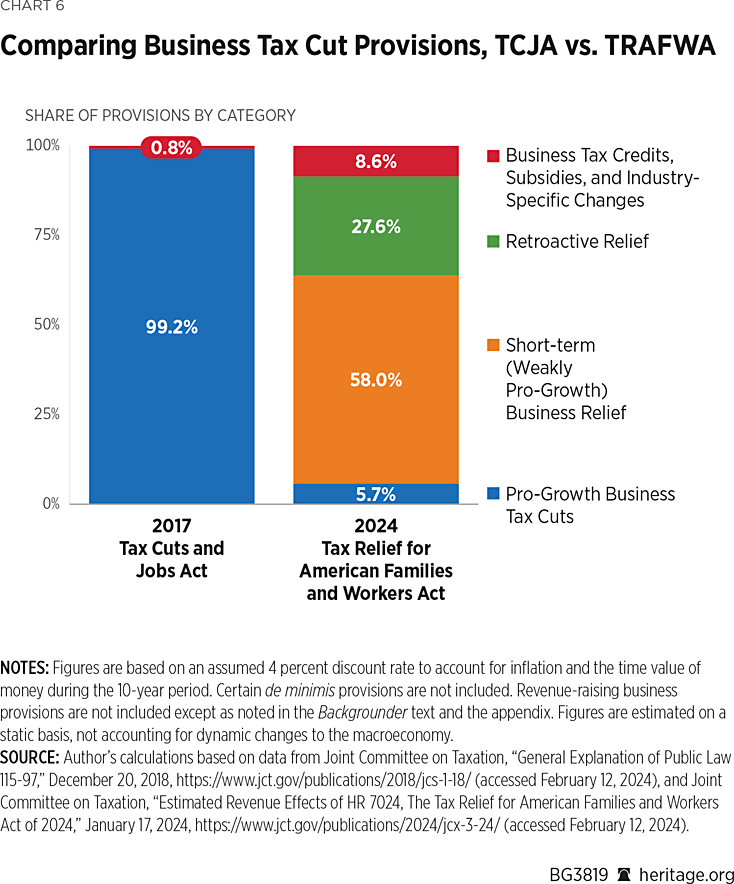
Conclusion
The 2017 Tax Cuts and Jobs Act is by no means perfect, but there was a sound basis for most of its reforms. The 2017 reforms generally improved economic incentives, lowered tax rates, and simplified the tax system. They also eliminated or pared back many unjustifiable carveouts. (Given the explosion of the national debt since 2020 and the rise in interest rates, lawmakers should make the elimination of unjustifiable tax expenditures a point of emphasis in the future).REF The 2017 legislation did, unfortunately, resort to temporary (though long-term) provisions, which set up the large 2025 tax cliff that lawmakers will soon have to navigate. However, even the temporary provisions were in effect for the better part of a decade, providing some continuity.
The Tax Relief for American Families and Workers Act meaningfully departs from the successful 2017 tax reforms and cannot be considered as merely carrying on the mantle of the TCJA. This latest bill predominantly consists of new cash outlays to individuals and retroactive and short-lived business tax relief that would have minimal effect on the economy. Instead of carrying on the 2017 legislation’s legacy of growth-oriented reform, much of TRAFWA follows the tradition of other tax-and-spend legislation coming out of Congress: It conflates short-term Keynesian stimulus with pro-growth reforms and conflates cash outlays to non-income taxpayers with income tax relief.
With any legislation, lawmakers must weigh the good with the bad. Both the 2017 TCJA and TRAFWA include some of both. The difference between the two pieces of legislation is in relative proportions. A healthy diet may include a small amount of desserts and fried foods, but a junk food–based diet is problematic. By the same token, as the 2025 tax cliff approaches, lawmakers should cut back on cash outlays to non-income taxpayers, corporate subsidies, and retroactive and short-term business tax relief.
Preston Brashers is a Research Fellow for Tax Policy in the Grover M. Hermann Center for the Federal Budget at The Heritage Foundation.
